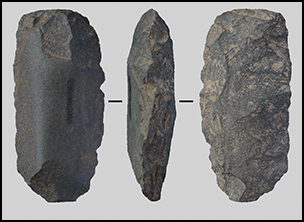Crossref Citations
This article has been cited by the following publications. This list is generated based on data provided by
Crossref.
Yang, Shi‐Xia
Deng, Cheng‐Long
Zhu, Ri‐Xiang
and
Petraglia, Michael D.
2020.
The Paleolithic in the Nihewan Basin, China: Evolutionary history of an Early to Late Pleistocene record in Eastern Asia.
Evolutionary Anthropology: Issues, News, and Reviews,
Vol. 29,
Issue. 3,
p.
125.
Yue, Jian-Ping
Li, You-Qian
Zhang, Yu-Xiu
and
Yang, Shi-Xia
2020.
Lithic raw material economy at the Huayang site in Northeast China: localization and diversification as adaptive strategies in the Late Glacial.
Archaeological and Anthropological Sciences,
Vol. 12,
Issue. 6,
Yi, Mingjie
Gao, Xing
Chen, Fuyou
Pei, Shuwen
and
Wang, Huimin
2021.
Combining sedentism and mobility in the Palaeolithic–Neolithic transition of northern China: the site of Shuidonggou locality 12.
Antiquity,
Vol. 95,
Issue. 380,
p.
292.
Yue, Jian-Ping
Yang, Shi-Xia
Li, You-Qian
Storozum, Michael
Hou, Ya-Mei
Chang, Yang
and
Petraglia, Michael D.
2021.
Human adaptations during MIS 2: Evidence from microblade industries of Northeast China.
Palaeogeography, Palaeoclimatology, Palaeoecology,
Vol. 567,
Issue. ,
p.
110286.
Mao, Xiaowei
Zhang, Hucai
Qiao, Shiyu
Liu, Yichen
Chang, Fengqin
Xie, Ping
Zhang, Ming
Wang, Tianyi
Li, Mian
Cao, Peng
Yang, Ruowei
Liu, Feng
Dai, Qingyan
Feng, Xiaotian
Ping, Wanjing
Lei, Chuzhao
Olsen, John W.
Bennett, E. Andrew
and
Fu, Qiaomei
2021.
The deep population history of northern East Asia from the Late Pleistocene to the Holocene.
Cell,
Vol. 184,
Issue. 12,
p.
3256.
Berger, Elizabeth
Brunson, Katherine
Kaufman, Brett
Lee, Gyoung-Ah
Liu, Xinyi
Sebillaud, Pauline
Storozum, Michael
Barton, Loukas
Eng, Jacqueline
Feinman, Gary
Flad, Rowan
Garvie-Lok, Sandra
Hrivnyak, Michelle
Lander, Brian
Merrett, Deborah C.
and
Ye, Wa
2021.
Human adaptation to Holocene environments: Perspectives and promise from China.
Journal of Anthropological Archaeology,
Vol. 63,
Issue. ,
p.
101326.
Izuho, Masami
Iizuka, Fumie
Buvit, Ian
and
Konstantinov, Mikhail V.
2022.
Problems associated with the age determination of the oldest pottery yielding cultural layers at the Studenoe 1 site, Transbaikal (southern Siberia).
Quaternary International,
Vol. 608-609,
Issue. ,
p.
120.
Lyu, Nanning
Li, Youqian
Yang, Shixia
Yue, Jianping
Tian, Feifei
Rao, Huiyun
Han, Bin
and
Yang, Yimin
2023.
Microdestructive analysis with Py-GC/MS for the identification of birch tar: a case study from the Huayang site in late Neolithic China.
The European Physical Journal Plus,
Vol. 138,
Issue. 7,
Zhao, Chao
Wang, Youping
and
Walden, John P.
2023.
Regional variation in the shift towards microlithization: The development of early microblade technology in North China.
Archaeological Research in Asia,
Vol. 34,
Issue. ,
p.
100441.





